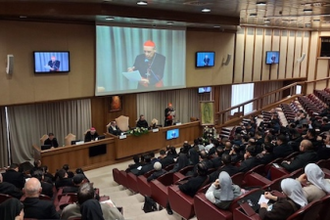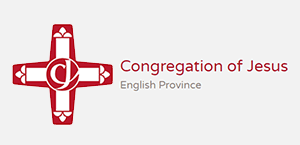Clare Asquith gives Allen Hall Lecture, 2025

William Shakespeare by John Taylor. Image: National Portrait Gallery
The Shakespeare scholar Clare Asquith, Countess of Oxford and Asquith, delivered the annual Allen Hall Lecture last week and declared: 'This must be English Catholicism's moment.' Under Pope Leo, she said, 'It looks as if the church will be now able to draw confidently both on the clarity and accessibility of reform - once Erasmus, now Vatican II - and the treasury of mystical and liturgical beauty dating back to the earliest times.'
Speaking in Allen Hall, the seminary of the Diocese of Westminster - built upon the site of the great Tudor humanist, politician and martyr St Thomas More's 'great house' - last Thursday 5th June, Clare Asquith entitled her talk the 'Enterprise of England' and paid homage to Cardinal William Allen's attempt to revive the 'ancient beauty' of the old religion in his native country following the Reformation.
Allen founded both the English Catholic College of Douai in Flanders and the Venerable English College in Rome, and Westminster's seminary is named in his honour.
Asquith contended that Allen's greatest success, missionaries apart, was in lighting a flame which for centuries sustained and vindicated the role of the beauty of the Catholic faith in literature. 'Four hundred years later, it seems the English have at last lost their suspicion of beauty in religion. They recognise that, in Cardinal Timothy Radcliffe's words, "the primary route to the joy of true holiness is through beauty and the imagination."
"How would Allen have imagined the re-conversion of England? How do we?" asked Asquith. She concluded: "Only Shakespeare I think came up with a realistic and vital vision: a consensus, not a synthesis, of the most full-blooded versions possible of the two great tendencies within the Christian Church - on the one hand, beauty, on the other, the reforming ideal of liturgical simplicity, direct inspiration, fidelity to plain doctrinal truth."
Clare Asquith has written two exciting books on Shakespeare and Catholicism - Shadowplay and Shakespeare and the Resistance - which I reviewed for America and The Tablet respectively. In her Allen Hall Lecture, she devoted attention to Cardinal Allen, Shakespeare and to the Jesuit martyr and poet Robert Southwell, who will be the subject of her next book, in the context of their response to the Reformation.
Read the full lecture below:
The Enterprise of England - Allen Hall Lecture by Clare Asquith, Countess of Oxford and Asquith
'The expense is reckoned; the enterprise is begun; it is of God; it cannot be withstood'. Thus spoke Edmund Campion, the most celebrated of the English Catholic martyrs; but the enterprise - the enterprise of the re-conversion of England - that was Cardinal William Allen's, after whom this lecture series is named, and to whom this particular lecture is dedicated. In 1568, this driven, inspirational, impoverished Lancashire academic, founded the English College at Douai in Flanders. Douai was the ideal launchpad for his project: a small, vibrant university town in the Catholic low countries, very like Bruges today. Allen's brainchild flourished. Similar colleges were founded in Rome, and in Spain. But the enterprise of England's re-conversion - in spite of Campion, in spite of Newman, in spite of the hundreds of lives, the thousands of words spent its cause - has been resolutely withstood for the last 400 years. Those who were openly Catholic in 1580s England are reckoned at ten per cent of the population. The figure is the same today.
The Unique Selling Point for Catholicism, and for many in the past, the stumbling block, has been its stress on beauty, and ritual. 'Give me back your ancient beauty,' wrote Campion to a friend of his who had become a Protestant bishop in England. A few weeks ago, in the Spectator diary, the composer James Macmillan ended his entry with a wish which echoes Campion's. 'I hope that the next Pope will emphasise and elevate the role of beauty, as well as truth and goodness. Our world needs all three.' A year ago, talking to the Synod about authority, Timothy Radcliffe made a persuasive case for the primacy of beauty. It is beauty, working on the imagination, he argued, that draws people to the spiritual life, rather than morality or dogma. But for us English, beauty in religion has been suspect for centuries. In the first part of this talk, I want to look at the reason why.
Scholars will go on arguing for ever about the nature of the events of England's Reformation, but they agree on one thing: in the course of the Sixteenth Century, a country culturally integrated for centuries rapidly split apart spiritually, psychically, into two conflicting halves. The old consensus on the beauty of the sacred arose directly from the doctrine of the Real Presence in the Mass.
The driest Catholic theologians became lyrical describing it. Allen called the Mass 'the love-knot between Christ and his spouse.'
Here, the divine and the human, the living and the dead, Purgatory, Heaven and Earth, met in mystical communion. But from the 1530s, Beauty was elbowed out by a literal adherence to scriptural Truth. To the eye of cold reason, the so-called mystery of the Mass was the fountainhead of all superstition, and 'repugnant to the plain words of scripture' as the Thirty Nine Articles still has it - which after all required no more than a supper table and the gospel text. Between 1534 and 1540, rationality and pragmatism - powered it must be said by a tidal wave of national avarice - de-consecrated the holy ground that covered much of England and monetized the ornamentation that had been lavished on it for centuries. Once people saw that trampling on the host and melting down the chalice earned cash instead of punishment, the game was basically up for the traditional religion. Newly enriched and ennobled lawyers, land agents, accountants, brokers, dealers - Machiavels and atheists according to Allen - took over the running of the country from the old aristocracy and gentry. Uprisings supporting the old order - most dangerous of which was the Essex rebellion - were efficiently defused by the Machiavels and their story skilfully rewritten. (An attempt to re-impose the beauty of holiness on the new state church under Archbishop Laud a few decades later led his death and a yet more rapid national descent into civil war. Laud fatally underestimated our hatred for the shreds and rags of Popery we had destroyed.)
In terms of England's national heritage, the loss was incalculable. Andrew Graham Dixon, the art critic, says that the only comparable event in terms of damage was China's Cultural Revolution. He analyses the impact of the iconoclasm on English identity. Once the 'intimate interweaving of this world and the next' had gone, so did the 'irrepressible vigorous eccentricity at the heart of the national imagination', what he calls the 'stirring strangeness' which we can still just detect in medieval English art. The little that survives tells of a time when the 'British were unimaginably different from the people they have become.' England's churches were 'battlefields on which the most vigorous war for the soul of the culture was once waged.'
I don't know how many of you have Ian McGilchrist's formidable books on your shelves. He is a Fellow of All Souls College, Oxford, a philosopher, psychiatrist, literary scholar, and neural scientist. His subject is the split between the right and left hemispheres of the brain - the right hemisphere being emotional, aesthetic, imaginative and the left hemisphere rational, analytical, logical. He sees our contemporary dependence on the left side of the brain - rational and analytical - as drastically mistaken. In his view, reason should be not the master, but the servant, of the imagination. Without this re-adjustment, McGilchrist sees Western civilisation heading for a cultural, spiritual, actual Doomsday.
The infliction of a deep psychic split between right and left seems to me the most accurate description of the trauma that overtook England in the Sixteenth Century when the literal and rational took a brutal hammer to the imaginative and beautiful. What happened to England of course did not stay in England - it powered the Protestant Reformation in Europe, and puritan emigration to America. The chain of events set off by the drastic policies of Henry VIII and Thomas Cromwell were I believe the source of the psychic disorder McGilchrist detects in the western world today.
In the second half of this talk I want to look at the response of three contemporary witnesses to the initial catastrophe: William Allen, Robert Southwell and William Shakespeare. Their solutions to the crisis which dominated their lives have since been either misunderstood or forgotten, and certainly did not all succeed, but they hold vital meaning for us today - when conditions have changed, and we can pick up and continue the work they began.
William Allen discussed, but dismissed, the simplest solution - assassination. [In 1570, Pope Pius V published Regnans in excelsis, a papal bull of excommunication and a call to treason against Elizabeth I which had a catastrophic impact on the Catholic community in England.] It looks as if Robert Persons, the fiery Jesuit, suggested the murder of the Queen and Allen rejected it. He did encourage invasion; he did encourage rebellion; he did encourage plots. They all failed. So did the formidable polemics written by his fellow exiles - most were confiscated on arrival at English ports and circulated only secretly. His outstanding achievement was to inspire a stream of highly educated missionaries to risk an appalling death in order to re-evangelise their country. Their example amazed their contemporaries - the Protestant poet Edmund Spenser praised the 'zeal of Popish priests who spare not to come hither by long and dangerous travel, where they know peril of death awaiteth them and no reward nor riches is to be found' and contrasted them with 'the idleness' of the new clerics, who 'would not be drawn forth from their warm nests and their sweet loves' sides to look out into God's harvests.' But even here it is arguable that Allen saw the mission as a failure: the attrition rate of the missionaries was terrible, as were the reprisals for those who sheltered them. At Allen's death in 1594, the Catholic mission to England was bitterly divided between those who recommended continued resistance, and those who wanted compromise.
But as so often when someone puts their all into a project, it does succeed in a totally unexpected way. Among Allen's pupils, arriving in Douai at the age of 15 in the July of 1576, was a young nobleman, Robert Southwell. His intellect was needle-sharp, coming as he did from a family of lawyers, but he was also a natural poet - in fact he was such an emotional young man that the Jesuits at first refused him. An outstanding classical scholar, Southwell went on to spend eight tough years as a Jesuit administrator and teacher in the English College in Rome, dealing with the bitter squabbles of Catholic expatriates. But at the same time he was working on a project of his own which was to use the native literary beauty of the medieval poetic tradition, to woo the English back to their spiritual heartland. [In the Nineteenth Century, similarly, the fellow Jesuit and poet Gerard Manley Hopkins re-captured 'the native thew and sinew of the English language' in his evangelizing work, composed during the 'Second Spring' of English Catholicism.] That is, to regenerate the country, not by means of reasoned argument and controversy, but by an aesthetic appeal to the imagination.
These works circulated at first in manuscript, and were published in 1595, the year of his execution, They were so uncontroversial on the surface that they satisfied the censors and become instant bestsellers: eight editions within four years of his death. Southwell prefaced them with punchy attacks on the triviality of late Elizabethan poetry, challenging English writers to follow his lead, and to write about things of the spirit and in the genuine native idiom rather than the phony Italianate Petrarchan style. His poems were not just beautiful in themselves, they celebrated beauty - a doctrinal beauty always rigorously supported by the intellect.
Southwell's cleverly deniable images also dramatised burning topical issues forbidden by censorship. Time for just one example:
A bitterly remorseful Saint Peter has just betrayed Christ. St Peter's Complaint moves agonizingly from utter despair through remorse to hope, using the favoured English motif of alchemy - at once colourful and spiritually profound - to track the spiritual journey. There is no doubt it would have reduced original readers to tears. Peter, totally broken, begins as defensive-aggressive, hating himself for the excuses he none the less makes. The first is She made me do it - the serving maid who drove him to deny his friendship with Christ. The same with the English - a woman's demand for allegiance cowed them into denying their religion, taking the oath of supremacy, attending the new church services. Cleverly, Southwell's Peter calls her a Porteress - the one who guards the door. Peter says yes, he betrayed Christ but so did many others: 'It seems no fault to do that all have done, / The number of offenders hides the sin.' Not true of those around that courtyard fire (Peter was the only denier) but true of the English (the excuse survives in the desecration of Roche Abbey). Furthermore, Peter compares himself to an obscure Old Testament figure, King Manasses. If the censor could be bothered to look him up, he would have found that Manasses was an iconoclast who desecrated the Temple in Jerusalem, ripped out the altar, and installed shrines to false Gods. Again, not at all like Peter, but exactly like the English. And as so often with Southwell there is hope - Manasses repaired the wreckage, so could England.
Southwell's poems please because of this kind of topical cleverness, but also the doctrinal rigour of mind that underlies the lyricism. Like medieval English windows, miniatures and mystery plays, his poems are small doctrinal time-bombs designed first to delight, then to instruct and persuade.
On the London literary scene, his challenge was taken up, the wit caught on. In came religious subjects and the more vigorous, demanding, original, English 'Metaphysical' style. The Metaphysicals are the early modern poets we read now - not Spenser and Sidney, but Donne, Herbert, Marvell, Crashaw, and Vaughan. [There is a strong link between meditative Metaphysical poetry and the Jesuits' Spiritual Exercises.]
Allen's project inspired martyrdom but also unwittingly inspired the use of the imagination to disseminate imperilled Catholic doctrine, allowing the beauty of holiness to permeate and moderate the intellectualised, rational, text-based 'left side' impact of the Reformation on English culture and soul.
An example: Southwell's single anthologised poem, The Burning Babe, is an emblem of dazzling alchemical strangeness, containing the entire Christian message in just sixteen completely original lines which Ben Jonson said he would have given his entire work to have written:
As I in hoary winter's night stood shivering in the snow,
Surpris'd I was with sudden heat which made my heart to glow;
And lifting up a fearful eye to view what fire was near,
A pretty Babe all burning bright did in the air appear;
Who, scorched with excessive heat, such floods of tears did shed
As though his floods should quench his flames which with his tears were fed.
"Alas!" quoth he, "but newly born, in fiery heats I fry,
Yet none approach to warm their hearts or feel my fire but I!
My faultless breast the furnace is, the fuel wounding thorns,
Love is the fire, and sighs the smoke, the ashes shame and scorns;
The fuel Justice layeth on, and Mercy blows the coals,
The metal in this furnace wrought are men's defiled souls,
For which, as now on fire I am to work them to their good,
So will I melt into a bath to wash them in my blood."
With this he vanish'd out of sight and swiftly shrunk away,
And straight I called unto mind that it was Christmas day.
Finally, let's look at the greatest and most influential of Southwell's successors, who took his work to another level, but also conveyed a new, even more vital message, still just as vital today. It is impossible to know whether Shakespeare spent time at Douai as some would argue or whether he learned the craft of 'two-edged words' from [his distant kinsman] Southwell, who, it is now recognised, had a powerful influence on him. What is clear is that Shakespeare was from the start the past master - the virtuoso - of Southwell's tightly allusive poetic technique. And it is clear that from the start he was more ambitious. His aim was not to convert and console like Southwell. Sponsoring Shakespeare were heavyweight patrons. Up front, dangerously so, were the bold young Earls of Essex and Southampton, and ranged cautiously behind them the angrily disaffected old nobility. The aim of these people was regime change. Essential to that change was religious toleration - including the return of Catholicism. Their role airbrushed from the record, like Southwell's life and work, they were the Elizabethan opposition. Shakespeare was writing for them.
In play after play, poem after poem, Shakespeare presents his readers with their own country's fit of madness, followed by his prescriptions for its cure. First phase, the self-harm - the destruction of the 'ancient beauty' of its own identity. Second, the splitting that resulted - left and right hemispheres. And third, the healing of the split, the reintegration of the country. This dream solution was not an impossibility then - the Earl of Essex held out a genuine prospect of religious toleration which in the 1590s was attracting supporters from all sides. (This is why Shakespeare's work operates 'for all time'; what was a unique post-Reformation English political dysfunction is also a common psychological one - the split between the right and left side of the brain, the prioritising of the rationalist emissary over its spiritual master, the need to understand the original trauma and rebalance the psyche.)
Let's look first at Shakespeare's Phase One: the destruction or threatened destruction of a figure representing truth, beauty and goodness; a sacramental beauty always presented in distinctly pre-Reformation terms - Desdemona, Cordelia, Hermione, Lavinia - above all, someone few of you will be familiar with: Lucrece. In his lifetime, his most admired work was a long narrative poem clearly influenced by Southwell - The Rape of Lucrece. Seen for what it is - not a weirdly long and unreadable rhetorical showpiece, but a decade-by-decade allegory of the impact of the Reformation on England - it is, as his contemporaries recognised, a masterpiece, and the best illustration of his method.
In the beginning a lustful, mercenary king, fed up with a follower endlessly boasting about his treasure (his wife, the true, good and beautiful Lucrece) wants that treasure for himself. In verse one he leaves the Roman host - wordplay from the start - and creeps in on her at night, with more wordplay at every point for his ever-attentive readers - for example, en route, the predatory king hoping his fears turn into dissolution. The sleeping Lucrece is a virtuous monument 'entombed', a heavenly image, holy, surrounded by incense, lit by a candle, a moon within a cloud, a fair and fiery pointed sun enclosed by a curtain, a pure shrine. Her rapist - after a long unlustful period of calculating the advantages of the grab - tears open the curtain and puts his foot upon the light - a massively symbolic line with the force of a political cartoon, and the summary of [the Catholic historian of the Reformation] Eamon Duffy's entire work: there is the royal foot stamping on the sanctuary lamp. Like Henry VIII, not like an ancient Roman, the remorseful Tarquin hopes his crime will get absolution.
Among Lucrece's protests is the equally profound line, as the old culture goes down: 'Mud not the fountain that gave drink to thee.' Here in ecological terms is the McGilchrist moment, the emissary polluting the master's life-giving water. Her father describes the loss in terms of a broken mirror. The rape and death have 'shivered all the beauty of my glass, that I no more can see what once I was'. After the rape she is a 'late-sacked island' - a 'pale dying swan in a watery nest' - but a sort of life continues after her death. Instead of a 'silver sea', her blood divides into two slow rivers which flow round the devastated land: one red, the other black. [Compare John of Gaunt's dying speech in Richard II.]
So in Lucrece the king - the greedy predator - is the destroyer of beauty. No time here for the whole passage attacking the opportunists who followed him, but there were other iconoclasts too, the genuine reformers, intellectuals and theologians, who saw the destruction of shrines and images as a tragic necessity.
In one of his greatest speeches, from Othello, and drawing I think on one of Robert Southwell's stranger poems, 'Joseph's Amazement', Shakespeare enters into the mindset of one who believes the old religion is fatally corrupt, but who sees no comfort, indeed no life, without it:
It is the cause, it is the cause, my soul,-
Let me not name it to you, you chaste stars!-
It is the cause. Yet I'll not shed her blood;
Nor scar that whiter skin of hers than snow,
And smooth as monumental alabaster.
Yet she must die, else she'll betray more men.
Put out the light, and then put out the light:
If I quench thee, thou flaming minister,
I can again thy former light restore,
Should I repent me: but once put out thy light,
Thou cunning'st pattern of excelling nature,
I know not where is that Promethean heat
That can thy light relume.
(Like Othello in the above soliloquy, by the way, Ben Jonson's joke Puritan, Zeal of the Land Busy, talks of his holy mission as The Cause).
There is a third group of English iconoclasts besides the profiteers and reformers - the workmen who actually did the job. Titus Andronicus features an anachronistic tourist gazing at a ruined abbey, reminding us of skeletal chancel arches ['the bare ruined choirs where late the sweet birds sang] and helping us interpret the plot. In this play, Marcus contemplates his niece, the good, true and beautiful Lavinia, another figure of holiness, who has been raped, her hands cut off, her mouth mutilated and tongue cut out. In case we miss her identity, he refers to the unknown rapist as 'some Tarquin'. He doesn't comment on pain or blood - instead she is inert: 'What stern ungentle hands /Hath lopped and hewed and made thy body bare/Of her two branches, those sweet ornaments/Whose circling shadows kings have sought to sleep in?' Those who assaulted her we learn later from the villain who instigated the assault 'Washed and cut and trimmed; and 'twas/Trim sport for them that had the doing of it' - all these terms are linked to the work of iconoclastic de-construction.
The second phase is the fallout after the destruction - the drama of the two divided red and black streams which are all that is left of Lucrece, one of them the beauty of the old religion (high, fair), the other the stripped down 'true' religion of Reform (low, dark). Repeatedly in his plays, a society, a family, a pair of friends or twins, are torn apart in a tempest or an act of violence, and long to be re-united, with each half labelled with oblique allusions to the religious divide - traditional identity on one side, reformist on the other. A vivid portrayal of this radical split opens the First Folio as the microcosm of society on the boat is shipwrecked in scene one of The Tempest, a passenger shouting out: 'Mercy on us, we split, we split…Farewell my wife and children; … farewell brother…We split, we split, we split.'
Splits in storms follow - in The Comedy of Errors (two sets of identical twins), Twelfth Night, Pericles, The Winter's Tale - while metaphorical storms separate others. (Storms and tempests were synonymous then with the Reformation.) For the thumbnail version, I'll go to the two close friends and their lovers separated by darkness and mischief in A Midsummer Night's Dream.
Here, the deluded changeable lovers pursue Beauty - tall, fair Helena, variously described as 'goddess, divine, rare, precious celestial, a painted maypole' - and Truth - 'short, dark, shrewish, heretical, rebellious' Hermia. Their lovers talk in terms of faith and adoration rather than love - the whole squabble is doctrinal: 'truth kills truth, o devilish holy fray' - and oaths come in frequently: 'a million fail confounding oath on oath'. If you skip the rest of the play and just read the lovers in the wood, you get Shakespeare's comic, political cartoon version of the divided country.
So much for the split. Finally, and most important for us, reunion. All these plays move from rending to mending. The repair most emphatically does not mean conformity. Shakespeare stresses distinction, individuality, within an overarching unity: here the persecuted Helena lamenting what she's lost. On the shadow level, she is recalling the pre-Reformation consensus between Truth and Beauty: a consensus that is restored by the end of the play. Speaking to Hermia, Helena recalls they were:
Like to a double cherry, seeming parted,
But yet an union in partition,
Two lovely berries moulded on one stem;
So with two seeming bodies but one heart,
…
Due but to one, and crownèd with one crest.
And will you rend our ancient love asunder,
To join with men in scorning your poor friend?
There is often a mystical aura to these reunions. Consider the end of one of his last plays, The Winter's Tale. We are in the chapel of a grand house where Hermione, embodiment of the abused and exiled ancient beauty, is revealed as a statue, ossified, seemingly dead, hidden for years underground as it were, as traditional Catholicism was in England then. By now Shakespeare sees her lost other half not as a sibling, but a daughter - the embodiment of a new native version of Christianity who values plainness, shuns ornament and ceremony, shuns compromise with the state, is shy of taking the lead role in Whitsun pastorals, but is magnetic and inspirational. An example of reformist identity, Perdita is described as a creature, who, if she began a sect, might quench the zeal of all other professors (believers) and make proselytes of whomever she liked, including women. Perdita, wordlessly, ends the play in her restored mother's arms. Once recognised ['It is required/You do awake your faith'], her mother, strongly associated with the Mass and the sacrament, changes from statue to living flesh.
So here is Shakespeare's final solution to the problem of a country torn between exiled right and left: suppressed tradition and reform; disgraced beauty and truth. He goes for a union in partition - two distinct entities in harmony, the master linking arms with the emissary. He never drops this consistent motif. In the final scene of The Tempest, traditionally his final play, black and white harmonise in a game of chess played by two tempest-tossed lovers whose parents were enemies.
This talk began with William Allen's attempt to revive the 'ancient beauty' of the old religion in his native country. It suggests that his greatest success - the missionaries apart - was in lighting a flame which for centuries sustained and vindicated the role of that beauty in literature. Four hundred years later, it seems the English - especially what Timothy Radcliffe calls that unexplored continent, the young - have at last lost their suspicion of beauty in religion. They recognise that, in Timothy Radcliffe's words, the primary route to the joy of true holiness is through beauty and the imagination.
This must be English Catholicism's moment, the moment Allen was waiting for. Under Pope Leo, it looks as if the church will be now able to draw confidently on the two interlocking hemispheres she embodies at her best - that is, the clarity and accessibility of reform - once Erasmus, now Vatican II - the fresh inspiration of Perdita, if you like - and the treasury of mystical and liturgical beauty dating back to the earliest Jewish times - the ancient beauty of Perdita's mother, Hermione. Southwell celebrates this union wonderfully in his marvellous poem on the Mass, 'Of the Blessed Sacrament of the Altar'. It is the true home of both:
The intellect: 'Here to delight the wit true wisdom is…what thought can think, what will doth best approve / is here obtained, where no desire is void.' But also the imagination: 'To ravish eyes here heavenly beauties are/ to win the ear sweet music's sweetest sound / to lure the taste the angels' heavenly fare, To sooth the sense divine perfumes abound / To please the touch he in our hearts doth bed / whose touch doth cure the deaf, the dumb, the dead'. Southwell ends his catalogue of the intellectual and sensual beauties of the Mass, with the challenging lines - 'and if to all, all this it does not bring / The fault is in the men, not in the thing'.
How would Allen have imagined the re-conversion of England? How do we? Only Shakespeare I think came up with a realistic vision - and, in McGilchrist's terms, an absolutely vital one: a consensus, not a synthesis, of the most full-blooded versions possible of the two great tendencies within the Christian Church - on the one hand, beauty, on the other, the reforming ideal of liturgical simplicity, direct inspiration, fidelity to plain doctrinal truth.
The mistake in the past has been to attempt to superimpose one on the other, or, most disastrous in England, to attempt to merge them. As Shakespeare emphasized, the hemispheres must remain distinct, mutually respectful, within the church as well as outside it. I will end with one of his very simplest final lines, from The Comedy of Errors. This early play is packed with theology - he changes the setting to Ephesus and fills the comedy with references to the dual nature of Christ that preoccupied and divided the two councils there. At the end, two identical twins argue about which of them goes first into the great reunion party in the abbey. These last lines are simple, clumsy, strangely unforgettable:
'We came into the world like brother and brother,
And now let's go hand in hand, not one before another."


















